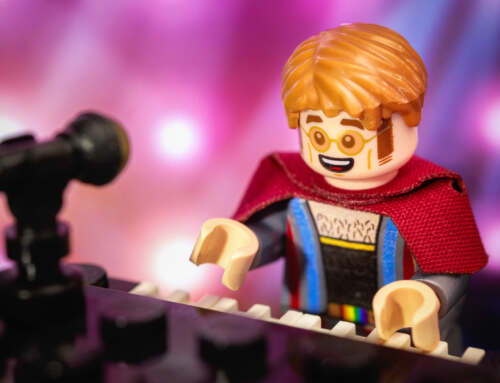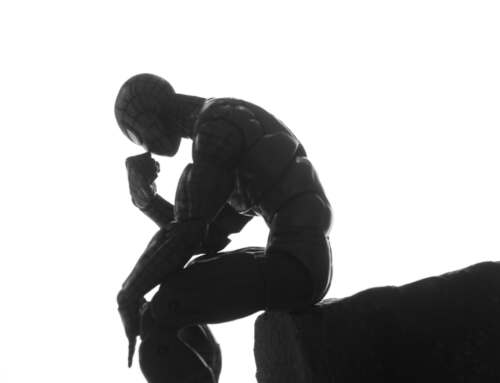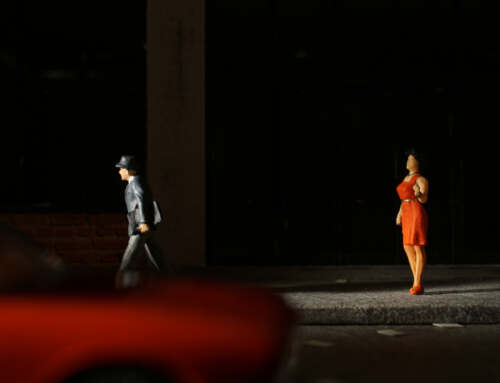Sometimes images come out of nowhere and other times there is a clear line of development. I thought I would share with you one of those moments. The story of the one image and the choices that were made along the way.
Inspiration
I enjoy looking at other toy photographs work. I’m inspired by their creativity and awed by their inventiveness. I like to think that in someway I will be able to reach their level of creativity and engagement. A couple of years ago I came across this image by Chris McVeigh which showed a robot looking at his reflection in a pond. The reflection is not a robot, but a little boy. I fell in love with that image; the robot that dreamed of becoming human. This past spring I watched Kristina set up a shot in a puddle. The beauty of this image reminded me of the image by Chris. While I’m inspired by other photographers, I try to not use ideas that have already been done, and done well.
Stuck in Plastic is running a competition on Robot photography. As we’re writing the article we’ve been examining why we’re attracted to the idea of robots. This has gotten me thinking about my own idea of being a ‘seeker‘ of knowledge, experiences and adventure through my own photography. I like to explore the ideas of what makes us human as well as explore my environment with a sense of child like wonder. I find Robots to be an appropriate vessel for these ideas. Combine that with a “whatever floats your boat” competition on BrickCentral and Brett’s #Legogirlstothefront challenge and it was time for an idea that has been percolating for some time in the back of my head to be attempted.
The Idea
My idea was to have two robots rowing across a pond. The female robot would be leaning over the edge of the boat looking at her reflection, transfixed by this first glimpse of her own face. I wanted the focus to be primarily be on her reflection rather than on the mini figures. I had no idea if this was possible, but you never know unless you try!
Location
The fountain in my front yard has remained silent for many years until this summer. My son took it into his head to fix it. He spent a couple of days dissembling it, cleaning it out and filling it up. It has one large pump in the middle and a smaller pump to move the balls in a circular motion around the pond. It’s a great location for a spur of the moment photo shoot.
First Attempt
My original vision was to place the robots in the row boat in the pond with the glass balls casting colored reflections across the surface of the water. I was hoping for a dream like, other worldly quality. I had an opportunity to add some bright, primary color to an image, rather than relying on the subdued colors of nature, and I wanted to see what would happen.
This image came the closest to the idea that was in my head. But now that I see the image, I find the color to be a distraction. Rather than focus on the main action in the boat my eye jumps around the surface of the image. I don’t know where to look! It’s a beautiful image, but the viewer can’t focus on the action. I consider this a beautiful fail.
Alternate View
As I often do when I’m struggling with an image, I changed my view point. When I looked away from the light and directed my lens to the shadows, the colorful balls were replaced with deep browns and blues. I like how the image is cut in half by the light and dark sides of the image and how this line combines with the angle of the boat. My biggest regret is the lack of clarity in the reflection.
Final Version
Somewhere between the color full version and moving my set up to face the shadows, I snapped this photo. The instant I saw it in my view finder, I dismissed it. I didn’t like the strong line created by the bokeh on the fountains edge.
Yet, when I looked at all of the images, this was the one I kept coming back too. There is a feeling of spontaneity in this image that is lacking in the others for me. The female robot seems more ‘alive’ in this image than in the others. I like the strong vertical line across the image and how it forces your eye back to the main subject. I also like how we can see more of the location, we aren’t as close as we are in the second photo. If I had really been on my game I would have managed to get the water moving too, but maybe I can leave that for the next time I attempt this image. I like the concept and I’m sure I will revisit it, maybe with different character, or maybe with the robots again.
For photographers, making choices can be extremely difficult. But it is in the deciding that we’re able to create our own style, our own vision and our own unique stories. I hope you enjoyed this peak behind the scenes into one photographers journey through that process.
~ Shelly
You have one more day to enter our Robot competition!












Love seeing the development process… Great image!
Thank you Margaret. Rarely is it this straightforward, that’s why I thought I would share the process. I’m glad you enjoyed the post! 😀
I really enjoyed your BTS post 🙂 it’s nice to understand the process in your shots. I hope it will help me when I’ll take the photos for the contest!
Im glad you enjoyed seeing a little more of what Im up to. You can search the bog for choices and find other posts like this. Friday the 12th is the deadline for the contest, I hope to see an entry from you! 😀
I really like your final shot Shelley. One question. How do you keep your boat afloat. I have a canoe which floats until I put my figures in it then it keeps rolling over. I was thinking of building a support post under it but was concerned that it might be visible through the water. Any tips would be gratefully accepted.
Great question Ann! I debated putting that little tidbit in the post, but ended up eliminating it since it was so complicated. My boats are always static. I’ve tried floatation devices, but trying to shoot a moving target with a short focal length is not easy!. I usually build up a platform under my boots with whatever is at hand. If you get low enough the reflections will disguise your support system. Usually I use rocks. In this case I used bricks. Ive built up platforms with Technique parts which works great, but you have to use rocks (or something heavy) to keep it floating away.I have seen a glass used to great effect. If I knew what my depth would be, that would be ideal. But I have to adjust depending where I find myself. If you look closely at this image, the dark shop under and to the left of the boat is the dark shape of the bricks supporting the boat. In the image, they also work as the boats shadow. I hope that helps! 😀
Awesome! I was wondering the same thing myself!
Thank you so much Shelly. That helps a lot. At least I know I had the right idea. Now to make it work.
This is a really insightful look into your own personal editing process, and it also reminds me of conversations that have sprung up about getting a photo “in camera” vs. editing afterwards. Even if someone gets their photo completely (but let’s be realistic and say mostly) “in camera” there is still much to be done afterwards as you have shown. The entire process of sharing an image is lengthy.
Recently, on Facebook, The Art of The Doll posted about this same process but in the context of how much photographers charge. Many people seem to expect we just show up and hit our shutter button and then that’s it. Not true though. People or toys, there is so much more that goes into a photo – the set up, the idea itself, the execution.
It’s all those same things though that create those images you linger on.
Thank you for your thoughtful comment; its always appreciated. I think photographers like myself and The Art of the Doll are trying to educate the next wave of photographers. There is so much more to photography than the camera. My husband is constantly telling me: photography is a conceptual medium. And thats just one of many concepts many photographers miss. I have been pushing here on the blog, in subtle and not so subtle ways, to encourage people to make choices, to edit their work and to ultimately print their images. It isn’t until you see it in your hand or hanging on a wall, that it is truly complete. Every image I publish on social media is only a sketch, an idea that hasn’t been completed. Photographers like Mike and Vesa tend not to publish much because they aren’t comfortable publishing sketches, or incomplete work. So you only see a small fraction of what goes into making one of their images. Me? I’ve always been about showing everything. I don’t think we can learn unless we share our experiences. I know, I’m a little off topic. 🙂
I don’t think you are off subject at all, especially considering the thoughts and post of the last few days. We’ve seen Brett questioning a recent change in how he approaches certain setups, your process behind selecting how to present a story, and my monsters coming back to life.
I’m not even sure a photo is complete once printed and framed. The first six photos I had in a gallery, I’ve since gone back and edited different versions of these. So I’m with you on the sketching, more than I realized!
I do love that second image, but you’re right, the oar and the light muddle the reflection of the female robot. And the story is the reflection, so good editing choice! The final choice tells the story well.
Thanks my friend, it was a hard choice. I really like the colorful version too! Who knows, I may have to revisit the issue and see what comes up next time. Or be happy with an image that is slightly flawed… There is a certain beauty in the flaws. 🙂